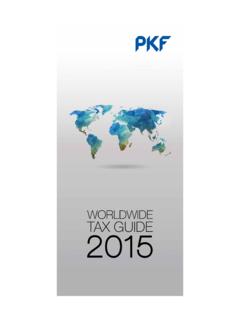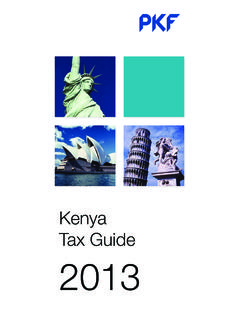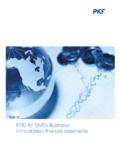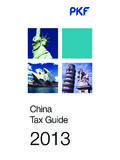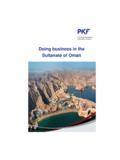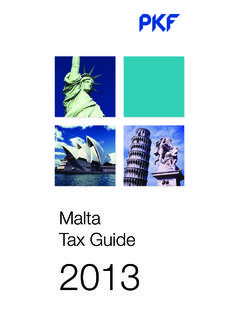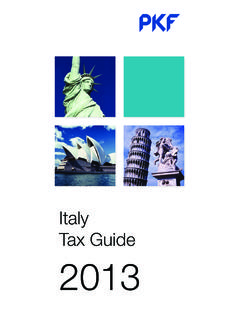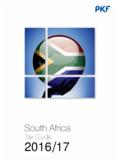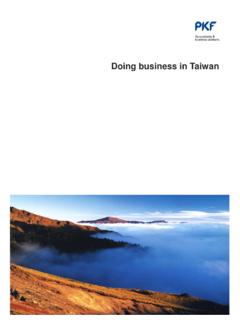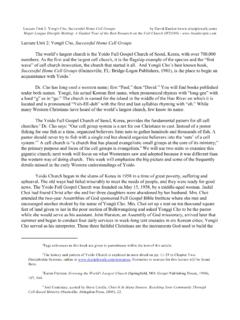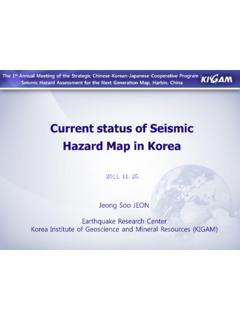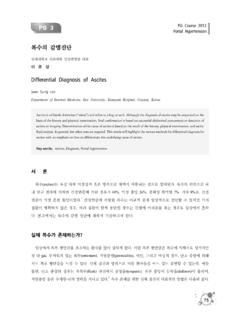Transcription of Doing business in South Korea - PKF International
1 Doing business in South Korea important disclaimer No person should act or rely upon any matter on information contained in or implied in this publication without first obtaining advice from a qualified adviser that relates specifically to their particular circumstances. This publication should not be regarded as offering a complete explanation of the taxation matters referred to. The publishers and the authors are not responsible for the results either of any actions taken on the basis of information in this publication, nor for any error in or omission from this publication. The publishers and the authors expressly disclaim all and any liability and responsibility to any person, who acts or fails to act as a consequence of reliance upon the whole or any part of the contents of this publication. Contents Chapter 1 Introduction 6.
2 Geography 6. Climate 6. Language and Currency 6. Legal System 7. Advantages of Investing in Korea 7. Constitution 8. Economy 8. Import Controls 9. Major Exports and Imports 9. Communications 10. Finance 10. Government Policy on Foreign Investment in Korea 11.. Exchange Controls Chapter 2 business Forms Available to Foreign Investment 13.. Local Corporation Establishment . Private business Registration . Establishment of a Foreign Company's Domestic Branch . Directors . Registration requirements and filing procedures for public securities . Shareholdings by non-residents Chapter 3 Accounting 18. business Accounting Standards . 18. Audit Policies 19. External Audit Policy 19. Introduction of the International Financial Reporting Standards 19. Chapter 4 Taxation 21. Introduction 21. Fiscal Year 21. Lodgement of returns 21.
3 National Taxes 22. Corporate Tax 22. Personal Income Tax 26. Capital Gains Tax 27. Value Added Tax 28. Composite Real Estate Tax 29. Local Taxes 29. 29. 30. 30. 30. x 31. Customs Duties 32. 32. 32. 32. 32. 33. 33. 33. 35. 35. 35. 35. ! " 36. # $ 36. %& 37. 37. ' ! 37. 38. ( 38. )*' 38. 40. Intellectual Property Rights Policy 40. Intellectual Property Rights 40. + 40. ( !, 41. - 41. % 41. + ! 42. 43. Employment for Foreigners in Korea 43. korean Labor Law 43. Visa 43. Procedures for Investors' Sojourn in Korea 44. + . 44. 45. / 45. 0 !+ 45. 1 + ! 46. 1 46. & / 46. 2 -+ 46. ! 46. + 304& ". 46. + 5 3 % 5 47. Introduction Geography The korean Peninsula, which lies on the northeastern edge of the Asian continent shares its northern border with China and Russia and juts toward Japan to the southeast. Korea is roughly 1,000 kilometers long and encompasses a total of 222,154.)
4 Square kilometers ( South Korea - 99,392 sq. km; North Korea - 122,762 sq. km). It is nearly the same size as Britain and a little larger than Portugal. The Republic of Korea is populated by million people as of 2008. Climate The korean Peninsula, which is situated at the eastern edge of the Eurasian continent, lies between 33 and 43 north latitude. With the Taebaek mountain range forming the backbone of the korean Peninsula, Korea has a diverse climate in spite of its small size. It lies in the temperate zone, and has four distinct seasons as well as diverse topography. The transitional seasons, spring and autumn, are generally sunny and clear, although they are short in comparison to winter and summer and have distinct weather patterns. Language and Currency In 1443, King Sejong promoted the creation of an alphabet for writing that could simply and accurately convey the sounds of the spoken language.
5 Originally known as Hunminjeongeum, or the correct sounds for the instruction of the people, it is an easy- to-learn phonetic alphabet that enabled the common people to express themselves in writing. Hangeul, as the alphabet has come to be known, is unique among the world's writing systems as its creation is well documented, including the date it originated and the names of the people who invented it. The unit of korean currency is the Won (indicated as ). Legal System The South korean legal system effectively dates from the introduction of the original Constitution of the Republic of Korea and the organization of South Korea as an independent state. During the existence of the Republic of Korea , the Constitution has been revised or rewritten several times, the most recent of which was in 1987 at the beginning of the Sixth Republic.
6 The Court Organization Act, which was passed into law on 26 September 1949, officially created a three-tiered, independent judicial system in the Republic of Korea . The revised Constitution of 1987 guaranteed that judges would not be removed from office for any reason other than impeachment, criminal acts, or incapacity. Additionally, the 1987 Constitution officially codified judicial independence in Article 103, which states that, "Judges rule independently according to their conscience and in conformity with the Constitution and the law." In addition to the new guarantees of judicial independence, the 1987 rewrite of the Constitution established the Constitutional Court, marking the first time that South Korea had an active body for constitutional review. The judicial system of South Korea is composed of the Supreme Court of South Korea , the Constitutional Court of South Korea , six High Courts, 13 District Courts, and several courts of specialized jurisdiction, such as the Family Court and Administrative Court.
7 In addition, branches of District Courts may be established, as well as Municipal Courts. South korean courts are organized and empowered in chapters V and VI of the Constitution of the Republic of Korea . There is no system of juries in the judicial system of South Korea , although since Feb 2nd 2008 a limited system of juries has been adopted for criminal cases and environmental cases, and all questions of law and fact are decided by judges. Advantages of Investing in Korea The Republic of Korea is located between China and Japan. Its geopolitical position has enabled Korea to act as a bridge for cultural exchanges and trade between its neighbors. In this regard, Korea is an optimal location for Doing business with China (the largest market in the world), and Japan (the world's 2nd biggest economy). North Asia is home to 25% of the world's population and generates 22% of its GDP.
8 (forecasted to increase to 30% by 2020). Korea has rapidly emerged as one of the world's leading ICT (Information &. Communication Technology) powerhouses. Korea 's excellent telecommunications infrastructure makes Internet use and maintenance easily affordable. Its outstanding edge and competitiveness enabled Seoul to rank top in the UN Global e-Government Survey. Korea 's e-Government program was exported to Moscow, Russia in 2004, and Hanoi, Vietnam in 2005. Korea is the world's 8th largest investor in research and development (IMD 2003). Annual R&D investment has increased steadily since 1997, well above the rate of GDP. growth. Although R&D investment temporarily shrunk in 1999 because of the economic slowdown caused by the Asian financial crisis, it has been on the rebound since 1999. The R&D investment in 2005 stood at US$ billion, or of GDP, which is close to the highest level in the world.
9 Korea 's responsiveness to the latest products and services make the country an ideal test bend. In fact, a number of global companies take advantage of this responsiveness to utilize Korea 's leading infrastructure and dynamic market. Constitution The Republic of Korea (commonly known as " South Korea ") is a republic with powers nominally shared among the presidency, the legislature, and the judiciary, but traditionally dominated by the president. The president is chief of state and is elected for a single term of 5 years. The 299 members of the unicameral National Assembly are elected to 4-year terms; elections for the assembly were held on April 9, 2008. South Korea '. s judicial system comprises a Supreme Court, appellate courts, and a Constitutional Court. The judiciary is independent under the constitution. The country has nine provinces and seven administratively separate cities--the capital of Seoul, along with Busan, Daegu, Daejeon, Gwangju, Incheon and Ulsan.
10 Economy Over the past four decades, Korea '. s impressive economic growth was part of what has been described as the "East Asian miracle." Intensive growth transformed Korea into the 12th largest economy and trading partner in the world in 2006. It was driven by high savings rates and investment and a strong emphasis on education, which boosted the number of young people enrolled in a college or university to one of the highest levels in the world ( in 2005). During those years, Korea '. s industrial structure was drastically reshaped. Major industries were diversified to include automobiles, petrochemicals, electronics, shipbuilding, textiles and steel products. By applying lessons from centuries of development in the West, Korea was able to make a similar transformation from an agricultural to manufacturing and on to a service-centered economy in just 50 years of time.

